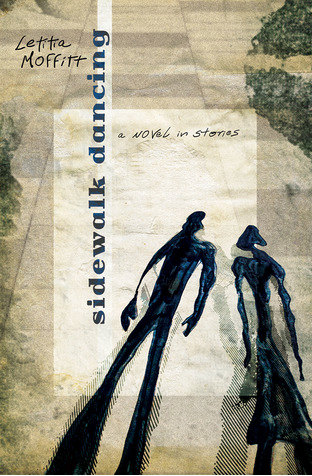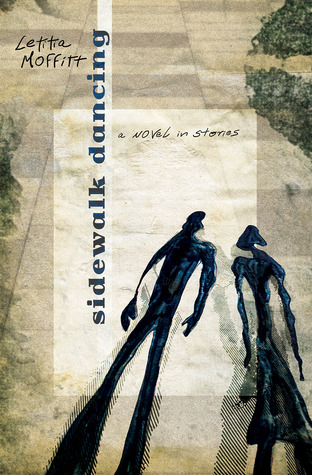 Sidewalk Dancing, published by Atticus Books, is the debut novel from local author, Letitia Moffitt. Don’t let the “debut” label fool you. Moffitt has been writing and publishing short fiction for years, with works showing up in places like PANK, Two Hawks Quarterly, and the Black Warrior Review to name a few. Sidewalk Dancing is a story of contrasts about familial relationships, written from the uniquely “other” perspective, of outsiders looking in on their own lives.
Sidewalk Dancing, published by Atticus Books, is the debut novel from local author, Letitia Moffitt. Don’t let the “debut” label fool you. Moffitt has been writing and publishing short fiction for years, with works showing up in places like PANK, Two Hawks Quarterly, and the Black Warrior Review to name a few. Sidewalk Dancing is a story of contrasts about familial relationships, written from the uniquely “other” perspective, of outsiders looking in on their own lives.
The novel is written in stories, and it centers around the McGee family, a trio of characters made up of George, a white father, Grace, his Chinese wife, and Miranda, the pair’s multi-ethnic daughter. Mostly told from Grace and Miranda’s point of view, the novel begins with Knives, a story with Grace at its focus. She is a recent immigrant to America who suffers through assimilating to her new surroundings while trying not to lose herself in the process. In this scene, Grace faces the challenges of language and how others stereotype her and take advantage of her situation.
The motivations were everywhere: when the woman with the poodle the same color as her fur coat cut in line at the grocery store; when the grocery clerk yelled at her to hurry up and added, Hey, you understan [sic] English? And then slower, louder, Hur-ry UP!; when she got home and realized she’d been charged too much for the fresh ginger because the cashier hadn’t known what it was. Of course there would always be the temptation to wish them all dead. But the knives weren’t about killing. They were about her, about who she was really.
Grace is tough as nails, almost to the point where the reader might wonder if there is any tenderness in her at all. She is stark, but she’s meant to be that way. Initially, I thought she was pessimistic, but Moffitt sees Grace a bit differently.
“I think of her as the realist rather than the pessimist,” Moffitt said. “I also think it’s in her nature to build a hard, protective shell around her as a barrier against the world, for whatever reason. Toughness, in her case as in others’, is borne out of fear.”
 Moffitt is at her best when Grace is front and center. Grace commands attention even though she might not want it. In fact, she doesn’t want it, even from George.
Moffitt is at her best when Grace is front and center. Grace commands attention even though she might not want it. In fact, she doesn’t want it, even from George.
In Model Home, for example, we see George as an idealist urban planner who drags his new bride from California to Hawaii. There, he designs a flawed, compartmentalized home for her. He runs for political office and works for groups like “Citizens’ Council For This” or “This Neighborhood Group For That.” He is a free spirit which is the complete polar opposite of Grace. In fact, you are led to wonder why George and Grace are together in the first place. He heaps praise on her foreign cooking skills, but it irritates her. “He’d failed to realize that obviously to her it wasn’t “Chinese food,” it was just—well, food.”
Their tension grows progressively worse with each chapter/story. In The Boat, George builds a vessel without having much nautical experience. His ill-conceived idea widens the rift separating the two to the point where you can’t help but wonder if the marriage is doomed.
Moffitt intended George to play opposite Grace’s realist perspective. “He’s definitely an idealist. I think he’s someone who was always a little different from people around him, and that made him see that the world can be different — which in his case led him to want to pursue perhaps the ideal version of that world,” Moffitt said.
Moffitt based George and Grace on her own parents and the character names reference the George Burns and Gracie Allen television show of the 1950s, known for their give and take dialogue. Sidewalk Dancing is very much based on Moffitt’s life, she said, but it is fiction.
“Miranda and I share some factual similarities—both grew up in Hawaii with multiethnic parents, both lived in New York for a spell, etc. But Miranda is a character I created. I think even writers of memoir create a “version” of themselves, an interpretation, and this sensibility is even greater in fiction,” Moffitt said.
Miranda is a mash up of her parents. Throughout the story we see George and Grace’s influence on Miranda, for good and bad. In Living Dead, we see Miranda search for an AIDS victim she helped in her insurance job, an initial idealism that borders on obsession, mixing both her father’s and her mother’s personality traits. I wondered if I’d read Miranda’s personality as Moffitt intended. “Yes! (That’s what I’d hoped to achieve, and since you said this, I’m delighted that I guess I was at least a little successful. I did want to show how she is “mixed” in many different ways.)”
There are challenges to writing a novel in stories. Some details are necessarily reintroduced from story to story. Most of these stories were published in other venues, and they can stand on their own. In a novel format, those details become magnified and, perhaps, more noticeable as the story moves forward. That said, Moffitt does a fantastic job walking the edge of a knife.
“I started to write this as a novel, but it just wasn’t working out. When I switched to stories, it was much easier. That said, it was still a big challenge to give the overall novel an “arc” —that is, a sense that all these separate stories were moving somewhere, building toward something. Also of course I wanted to avoid having to bring up the same background info every single freakin’ time,” she said.
Some chapters are in Grace’s point of view, others in Miranda’s and George’s. Sidewalk Dancing is an amazing novel of contrasts, frustrations, dreams, and disappointments.
Sidewalk Dancing is published by Atticus Books. It is available for preorder on Amazon.








